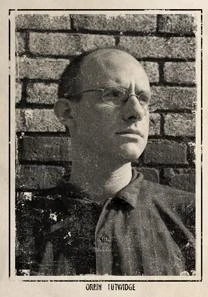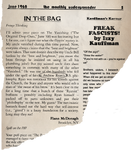
|
"Oh magus, you have begun thy journey. Your master's temple has fallen but his work is not yet finished…" - Orrin Oscar Lutwidge
This article falls within the scope of the BioShock Wiki:Something In the Sea Content Project. This project is dedicated to improving the quality of all content related to the viral website, "There's Something in the Sea." Would you kindly help the BioShock Wiki by volunteering on the project page?
|

|
"...if you're going to do such things, at least you should
do them properly." - Brigid Tenenbaum This article, The Monthly Undergrounder , or a section of this article may require overall cleanup.
|
The Monthly Undergrounder is a counter-culture periodical, referred to as a "hippie magazine" in a phone call from Phil Isidore. In June 1968, this magazine ran an article about The Vanishing, titled "The Original Drop-Outs: The Secret History of the Vanishing" by Colin Anton Ressnak. This article mentions several groups and people who researched the Vanishing, including Celeste Roget and the James Millard Oakes League. The article goes into greater depth on Orrin Oscar Lutwidge. It tells of his background, his strange encouragement of the other conspiracy theorists, and his own disappearance after 1958 in search of "true Rapture". The June edition of the Monthly Undergrounder also featured a reader's letter from Flann McDonagh, who dismissed the idea that all of the vanished were "brilliant" in some way, saying instead that the real connection between them was the belief in Andrew Ryan's capitalist philosophies.
In May 1966 the magazine also published an interview with Lee Wilson Seward, entitled "The Grey Ghost of Tangiers." This article mentions that Seward's sister and lover both vanished in 1946.
There's Something in the Sea[]
- Main article: There's Something in the Sea
Mark Meltzer first discovered this article of the Monthly Undergrounder in June 1968 after receiving a phone call from Phil Isidore that mentioned the article about "The Vanishing". This led Mark to research the possible connections between the Vanishing and the kidnapping of young girls all around the world, including his own daughter Cindy, in 1967. After Mark received the "Rise, Rapture, Rise" album in July, Lutwidge's quote in the article, "true Rapture," made Mark question whether Lutwidge might know the location of the "Rapture" where the vinyl disk had been made. This led to Mark's investigation of Lutwidge. Later, during Phase Three, Mark read the interview with Lee Wilson Seward to find out more information about the "Grey Pawn".
Article Fragment Transcripts[]
"The Grey Ghost of Tangiers"[]
22 the monthly undergrounder
May 1966 | ||||||||||
THE GREY GHOST | ||||||||||
| of TANGIERS | ||||||||||
| ||||||||||
May 1966 the monthly undergrounder
23 |
MU: You've been accused of being involved in their disappearance. |
"The Original Drop-Outs: The Secret History of the Vanishing"[]
12 the monthly undergrounder
June 1968 | ||
the original | ||
| drop-outs: | ||
| The Secret History of the Vanishing | ||
| BY | ||
| COLIN ANTON RESSNAK | ||
In the wake of World War II, hundreds - possibly thousands - of |
||
| Where did they all go? | ||
| And why? | ||
I'm sitting in the sun dappled kitchen of a Burbank prefab house on an unseasonably warm | ||
14 the monthly undergrounder
June 1968 | ||
Arthur Gene Tuggle and his wife are among a handful of people around the world looking into | ||
Many suspect the Vanished are simply individuals who became disgusted with modern | ||
| (cont'd page 19) | ||
Article about Orrin Oscar Lutwidge[]
June 1968 the monthly undergrounder
22 |
kookier than JFK assassinations theorists, further out than flying saucer buffs, the small
circle of "Vanishing" researchers includes some pretty unusual characters. One of the
oddest was Orrin Oscar Lutwidge.
Orrin Lutwidge was best known as an inventor.
His real passion was building mechanical
puzzles but his fiendishly difficult devices never
caught with toymakers. Instead, he made
a tidy sum developing patented concepts for
manufacturing, including dozens of innovations
for the printing and reproduction industries.
Like a less ambitious Buckminster Fuller,
Lutwidge was a restless polymath, dabbling in
numerous fields. He authored books and
articles for young readers; he allegedly con
sulted with the U.S. government on code-
breaking during World War II; and of course,
he pursued his on eccentric research into
"The Vanishing." Being Lutwidge, he did it in
his own uniquely baffling way.
For most of the "true believers," The Vanishing
is a bit like a psychologist's inkblot test. When
the look into the inexplicable abyss that this missing mass of people left behind, they see
some exotic never-land here on Earth. The paranoid see dark government agents at work.
And right wing nutters, inevitably, see the Commies.
Lutwidge, apparently, saw all these possibilities — and more.
June 1968 the monthly undergrounder
23 |
He corresponded with Celeste Roget, providing dozens of links amplifying her post-
Blavatskian notions of Ascended Masters and lost Himalayan cities. He wrote letters to
the James Millard Oakes League, offering behind-the-Iron-Curtain whispers from samizdat
newsletters, hinting at coordinated plans to eliminate the West's best minds. He quietly
forwarded news-clipping about missing individuals to the Tuggles, extending their ever-
growing list.
But Lutwidge never, ever offered up a theory of his own. Instead, he seemed to throw
his full support behind whatever theory his most recent correspondent believed.
Maybe he was being guarded; or maybe he was just being polite. Or possibly it was just
a symptom of the insanity that some claim overtook Lutwidge in his later years. Between
1956 and 1958, Lutwidge's correspondence became increasingly erratic, laced with frag-
ments of poetry, nonsense phrases and references to children's literature. In one of the
last letters he ever wrote, he claimed that no on would hear from hi, again until he
had found "true Rapture." No one know exactly what he meant. All that's clear is that
shortly after he wrote that cryptic phrase, he disappeared without a trace — leaving
projects half-complete and business arrangements in utter disarray. He had vanished as
utterly as any of The Vanished.
In The Bag[]
June 1968 the monthly undergrounder
5 |
- IN THE BAG
Fringe Thinking
I'll admit your piece on The Vanishing ("The
Original Drop-Outs," June '68) was fascinating but
I, for one, can't figure out what the flippin' mystery is.
My uncle vanished during this time period. Now,
everyone always claims that the "best and brightest"
were taken. That sure doesn't describe my Uncle Bill
(unless by the "best and brightest," you mean the
brass fittings he insisted on using in all his
plumbing jobs!) But my sainted uncle does share
something in common with many of the other
"Vanished." He was one of the hundreds who fell
under the spell of fat-cat Andrew Ryan's B.S. phi-
losophy. Ryan was notorious for his screeds against
the Church, the State and anyone who would rob a
man of "the sweat of his brow." It's been clear to me
for a long time that a bunch of these "Ryanist"
buffoons — possibly including Ryan himself —
packed off to parts unknown and put their
"philo$ophy" to the test. My guess? The narcissistic
found out the hard way that self-interest
(i.e., "greed") is a lousy foundation for a society.
Long may they rot!
- Flann McDonagh
- Brooklyn, NY
- Flann McDonagh
Gallery[]
References[]
- ↑ Norman Mailer, Henry Miller, and William S. Burroughs, all considered to be influential authors in the Beat Generation; Wikipedia
- ↑ Haight-Ashbury, street intersection in San Francisco known as the center of the "Hippie" movement in the 1960s; Wikipedia








